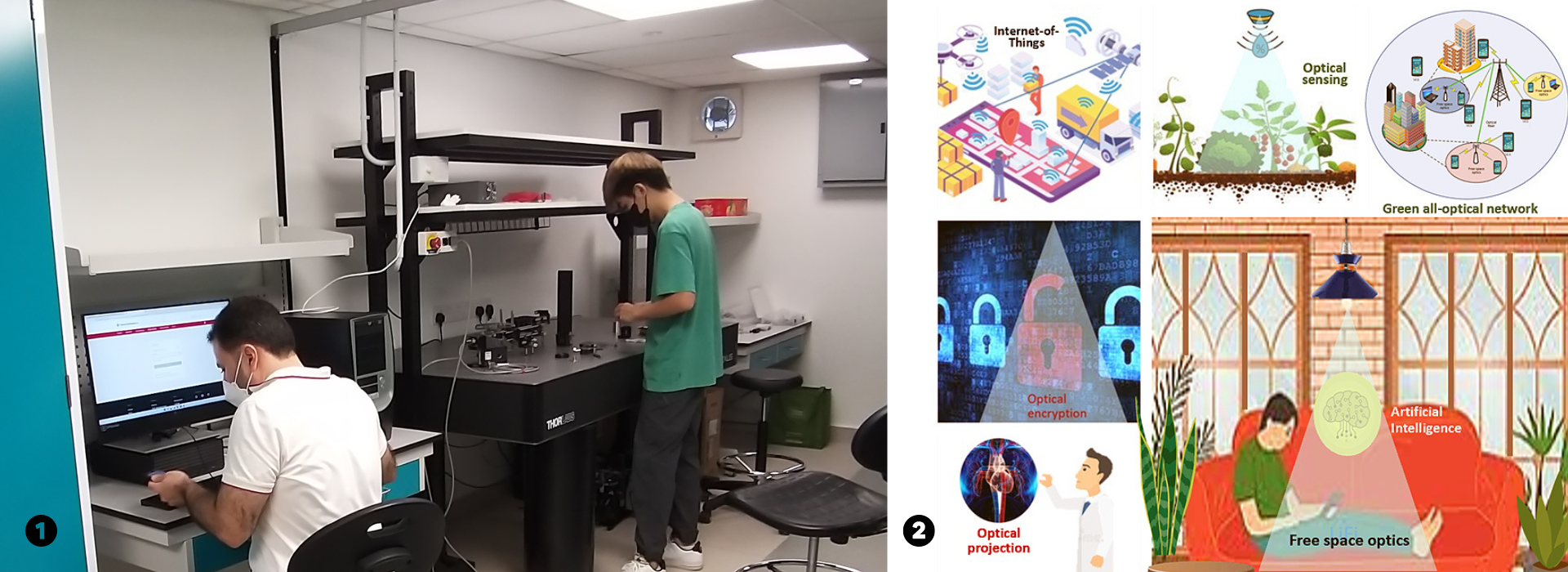Smart Photonics Research Laboratory
Discovering new forms of light for enhancing wireless data communications and diagnostics
An Overview
Have you ever wondered how we are able to send a large file through email, read an article on our smartphones, take mesmerizing photos from cameras or perform facial recognition? These are all driven by light. Different aspects of light, such as colour, brightness, frequency and phase, allow us to control information in bits - the alphabet of our digital world today.
How do we use light waves for sensing and sending information? Light waves have a higher frequency than radio waves on the electromagnetic spectrum. This allows light to rapidly encode, process and transmit information. Some frequencies of light are also visible to the human eyes, making it possible to view information such as text, images and videos using light. It is also possible to detect changes in the environment using light. Thus, leveraging different aspects of light has driven industries such as telecommunications, computing, imaging, medicine, autonomous vehicles, manufacturing, robotics and many more.
Wireless data communications using infrared light waves, known as free space optics, is important for future 5G, 6G and Internet-of-Things communication networks, working in tandem with radio frequency wireless communication systems, for increasing the data capacity and coverage, especially in high-density populations. Free space optics communications operate on an unlicensed spectrum, thus reducing spectrum costs and relieving the overwhelming pressure on the congested radio frequency spectrum. Free space optical channels are also immune to electromagnetic interference generated by radio frequency devices and networks. For indoor environments, light-emitting diodes are used for lighting and increasing the communication coverage area.
In a typical beam from a laser light source, there are millions of electromagnetic eigenmodes which could be used to represent information. Largely untapped for decades, the abundance of electromagnetic eigenmodes is now being harnessed for data representation, transmission, and diagnostics. Data transferred by a light eigenmode theoretically remains in this state as it travels through the air. Light eigenmodes are orthogonal and unbounded, hence the plurality of light eigenmodes promotes massive data parallelism from billions of devices for sensing and data analytics.

1. Smart Photonics Research Laboratory at Sunway University
2. Applications of free space optics
The Focus
The Smart Photonics Research Laboratory at the School of Engineering and Technology, Sunway University focuses on investigating how light can be sculpted into spatial eigenmodes for enhancing wireless data communications, information processing and sensing. The Photonics Research Laboratory is investigating various eigenmode forms for sensing and data communications. This includes eigenmodes carrying orbital angular momentum or twisted light for beam multiplexing. Artificial intelligence is drawn to accelerate certain aspects of system design and data retrieval.
Collaboration
The Smart Photonics Research Laboratory collaborates with Massachusetts Institute of Technology, University of Melbourne, Nanyang Technological University, Multimedia University, Universiti Malaysia Perlis, Universiti Malaya, Universiti Kebangsaan Malaysia on various technologies related to telecommunications, sustainability, sensing and education. The laboratory has research grants amounting to RM4 million from the Fundamental Research Grant Scheme, Long Term Research Grant Scheme, Telekom Malaysia Research & Development and others.

Potential and Prospects
The Head of the Smart Photonics Research Laboratory, Prof. Ts. Dr. Angela Amphawan, highlights the benefits of orbital angular momentum multiplexing in free space optical communications for enhanced information capacity. The laboratory is set for exciting prospects in free space optics and space division multiplexing, for diverse application areas. Prof. Dr. Angela Amphawan holds a PhD in optical communications from the University of Oxford, UK and was awarded a Fulbright Fellowship at the Massachusetts Institute of Technology, Cambridge, USA. Other previous positions she has held include Dean of Academic Affairs and Deputy Vice Chancellor. She is on Stanford University's list of the world's top 2% scientists.
If you are intrigued by light, join us at the Smart Photonics Research Laboratory for a journey of discovery!



